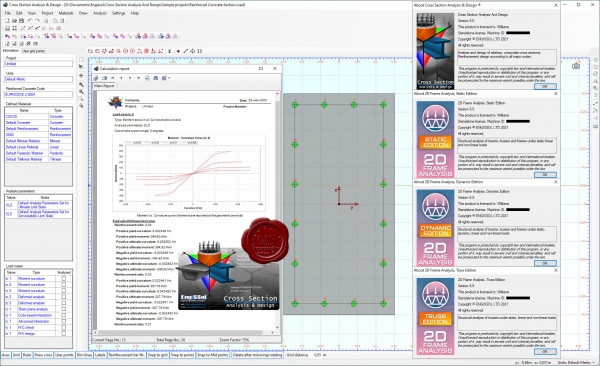
Cross Section Analysis & Design (top rated structural software in America, Europe, Asia and Australia) is a powerful application that can perform a wide range of cross section calculations, including the design of reinforced concrete sections (rebar calculator). The provided cross sections can be simple or complex and can consist of one or more geometric entities (rectangles, polygons, circles, arcs etc.). The geometry of the cross section can simply be drawn using the versatile featured user interface. The user can also import standard steel sections from a complete shape library according to all major codes (AISC, Australian-New Zealand, BS, Chinese, European, Indian, Aluminum etc.)
There are no limitations regarding the shape, materials or loads of a section, as the program can handle any arbitrary cross section under biaxial bending and axial loads (Mx,My,P). Among its capabilities, Cross Section Analysis & Design can calculate all sectional properties, plot Moment – Curvature and Interaction diagrams, estimate the location of the neutral axis under given sets of biaxial loads and plot the corresponding strain diagrams as well as the resulting stress contours. These items can also be calculated by providing the location of the neutral axis plane on the section.
Moreover, the program fully complies with the following codes concerning reinforced concrete sections: AASHTO, UBC, AS 3600, IS 456, ACI 318, BS 8110, CSA A233, EC2, NZS 3101, CP 65.
With just a few clicks, the user can perform a reinforcement design according to above listed codes, plot the matching interaction diagrams etc., or check a given reinforcement pattern under the specified load cases.
The stress – strain curves of concrete, reinforcement and other materials are specified parametrically using Analysis Parameters Sets. Each load case is assigned with an Analysis Parameters Set, so that calculations can be performed for many design situations, such as Ultimate/Serviceability or custom defined Limit States, with an automatic adjustment of the material properties, safety factors etc. For instance, when choosing the default ULS Parameters Set, the concrete curve will be rectangular and its tensile strength will not be considered. On the other hand, the default SLS Parameters Set, uses a hyperbolic stress-strain curve for concrete taking into account its tensile strength. The safety factors in this case are automatically adjusted to be 1.0. These parameters can be directly changed by the user.
A large material library is also available according to almost all concrete/reinforcement material specifications. Apart from concrete and reinforcement materials, the user can also specify custom linear, bilinear, trilinear parabolic or fully general materials.
2D Frame Analysis software package has been synonymous with state-of-the-art analysis of general and arbitrary frames and trusses in 2d space since its introduction over 14 years ago. Its user interface which is proven very sophisticated, intuitive and versatile is powered by a modern analysis engine which allows fast calculations and produces reliable analysis results. From its easy graphical modeling environment to the wide variety of analysis options, 2D Frame Analysis package has proven to be the most integrated, productive and practical general purpose structural program for static, dynamic, linear and non-linar (P-Delta effects) analysis of 2d frames or trusses. 2D Frame Analysis package has been designed to be very easy and fast in its use. Therefore, the user can conveniently take advantage of a great variety of features that are shown below in brief. Steel section and predefined materials list updated, major interface improvements, creation of completed professional looking calculation report, stress calculation added, all major measure units added.
Static Edition
Software application for the static analysis of any kind of plane structure including frames or trusses. The user interface is comprehensive, multi-parametric and inspectional. Joint and element loads are defined at local, global or projected global coordinate systems. End releases of degrees of freedom can be applied considering either partial or zero stiffness values. Linear and non-linear static analysis (second order analysis) are supported. Axial/shear force and bending moment diagrams are produced automatically. Nodal displacements, internal forces and deformed configuration are represented professionally. A calculation report is produced automatically.
Dynamic Edition
Software for static and dynamic (response spectrum and time history) analysis of frames, trusses and arbitrary plane structures. The dynamic modes are automatically calculated by advanced and robust algorithms with fast convergence and the corresponding modal shapes are represented graphically. Supported dynamic loads include response spectrum and time history cases in both x and y directions. After the completion of the analysis, a comprehensive calculation report is automatically created, which is exportable to pdf, doc and xls formats. Non-linear static analysis (second order analysis) for the consideration of P-Delta effects is also supported.
Truss Edition
Software for analysis of 2D trusses. It features a powerful finite element solver to analyze trusses consisting of elements with rotational releases at their both ends. The deformed configuration and the internal force diagrams of the structure are represented graphically. The creation of the model is easy and quick as the user can take advantage of the intelligent user interface of the software. Its versatile graphical user interface, the predifend libraries of cross sections and many other available features can save you time and effort. Moreover, the program also supports non-linear static analysis (second order analysis) for the consideration of P-Delta effects.